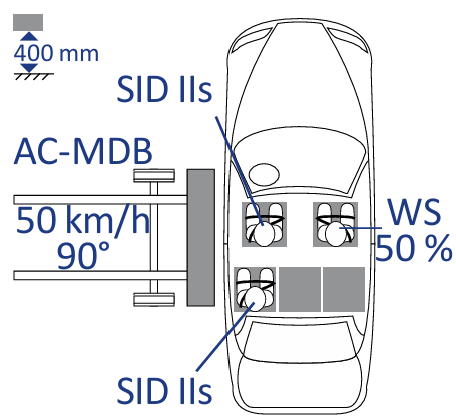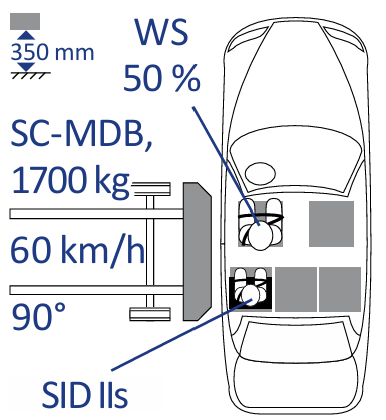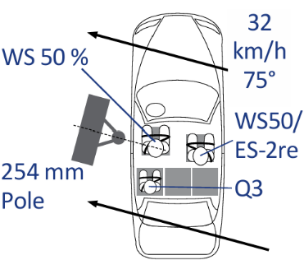1.Introduction
In side-impact collisions, the fatality risks for far-side and near-side occupants are comparable [1-2]. According to international statistical data, approximately 30% of injuries in side-impact crashes occur to far-side occupants, with 43% of these injuries classified as AIS 3+ on the Abbreviated Injury Scale (AIS). The AIS, developed by the American Medical Association based on extensive research data, is a standard for assessing automotive safety, categorizing injuries into six levels, where AIS 3+ denotes severe injuries [3]. In China, statistical data from the China In-Depth Accident Study (CIDAS) indicate that about 49% of injuries in side-impact crashes occur to far-side occupants, and approximately 36% of these injuries reach AIS 3+ severity. Given the injury characteristics of far-side occupants in side-impact collisions, extensive research has been conducted both domestically and internationally. In 2007, Pintar et al. analyzed the injury characteristics of a 50th percentile male dummy under far-side impact conditions. Their study utilized the Global Human Body Models Consortium Active Muscles 50 (GHBMC AM50) finite element model to simulate far-side collisions. Additionally, they conducted a series of Post-Mortem Human Subject (PMHS) sled tests to validate the simulations. Their research examined key factors such as seatbelt pre-tensioning parameters, impact intensity, and impact direction and further analyzed the sensitivity of occupant motion to these factors in far-side impacts [4]. In 2014, Y. Narayan et al. analyzed crash data from the National Automotive Sampling System Crashworthiness Data System (NASS-CDS) of the U.S. National Highway Traffic Safety Administration (NHTSA). Their study examined the impact characteristics, injury mechanisms, and severity of key dummy body regions—head, chest, abdomen, pelvis, upper limbs, and lower limbs—under various seatbelt restraint conditions in far-side collisions. Their findings provided insights into the injury mechanisms and patterns of far-side occupants [5]. In 2017, A. M. Edwards et al. combined finite element simulations and full-scale vehicle crash tests to analyze how factors such as inflatable seatbelts and differences in shoulder belt anchorage positions affect the injury outcomes of Hybrid III and THOR-M dummies in far-side impact scenarios [6]. In 2022, Yang Mingjun et al. conducted sled tests on a specific vehicle model following the far-side occupant protection test and evaluation protocols of the European New Car Assessment Programme (Euro NCAP). They analyzed and compared motion posture characteristics, body injury conditions, and response times between male and female occupants under side-impact conditions. Their findings indicated that in far-side impact tests, the lower neck bending moment injury value of a 5th percentile female dummy was 2.2 times that of a 50th percentile male dummy, highlighting significant differences in injury risk [7]. From the studies mentioned above, it is evident that most research has focused on evaluating far-side occupant injuries based on European and American automotive safety assessment protocols. However, there is a lack of research on far-side occupant injuries under different side-impact conditions in Chinese automotive safety evaluations. Moreover, most studies have focused on the injuries and motion responses of individual occupants, with limited research on the interactions between two front-row occupants in far-side collisions. To address this gap, this study employs ES-2re dummies to simulate far-side impact scenarios using three different side-impact barriers—AC-MDB, AE-MDB, and 75° POLE—on a selected vehicle model. Finite element simulations will be conducted to analyze the motion postures and injury outcomes of two front-row dummies in far-side impact conditions. By comparing the injuries sustained under the three impact conditions, this study aims to evaluate the severity of injuries and identify the most severe side-impact scenario. This approach will allow automotive developers to focus on the worst-case scenario for far-side occupant protection, reducing computational and time resources during vehicle safety development.
2.Simulation Analysis of Far-Side Occupant Protection Under Different Side-Impact Conditions
2.1.Three Side-Impact Conditions
In the China Insurance Automotive Safety Index (C-IASI) side-impact test, the Advanced Chinese Mobile Deformable Barrier (AC-MDB), which conforms to Chinese standards, is used to impact the driver’s side of the test vehicle. The AC-MDB moves perpendicular to the vehicle’s longitudinal center plane, with its longitudinal centerline aligned with the vehicle’s impact reference line. The impact velocity is set at 50 km/h with an allowable deviation of ±1 km/h. In the test, a SID-IIs (D version) dummy is placed in the driver’s seat and the left rear seat, while a WorldSID 50th percentile dummy is positioned in the front passenger seat. The test evaluates the injuries sustained by the driver, left rear passenger, and front passenger while analyzing the kinematics of the dummies. The schematic of this test condition is shown in Figure 1.

Figure 1. C-IASI AC-MDB Test Condition Schematic
In the China New Car Assessment Program (C-NCAP) side-impact test, a Suitable for China Mobile Deformable Barrier (SC-MDB) is mounted on the front of a moving sled to impact one side of the test vehicle, with the impact side randomly chosen as either the left or right side. The sled moves perpendicularly to the test vehicle, and its centerline is aligned 200 mm behind the R-point of the front seat on the impact side. The impact velocity is set at 60 km/h with an allowable deviation of 0 to +1 km/h. The distance between the sled’s vertical center plane and the vehicle’s transverse plane passing through the front seat R-point (200 mm rearward) must be maintained within ±25 mm. A WorldSID 50th percentile dummy is placed in the front seat on the impact side, while a SID-IIs dummy is placed in the rear seat on the impact side to measure and evaluate occupant injuries. The schematic of this test condition is shown in Figure 2.

Figure 2. C-NCAP SC-MDB Test Condition Schematic
In the C-NCAP side pole-impact test, the vehicle is either slid or driven laterally into a rigid pole, causing an impact on the driver’s side. The collision velocity vector must form an angle of 75° ± 3° with the vehicle’s longitudinal centerline. The rigid pole’s surface centerline must align with the intersection of the vehicle’s exterior surface and the vertical plane passing through the dummy’s head center of gravity (i.e., the impact reference line). In the plane perpendicular to the vehicle’s motion direction, the deviation from the impact reference line should be within ±25 mm. The impact velocity is set at 32 km/h with an allowable deviation of ±0.5 km/h, and the vehicle must maintain a constant speed for at least 0.5 meters before impact. A WorldSID 50th percentile dummy is placed in the driver’s seat, while an ES-2re dummy or another WorldSID 50th percentile dummy is placed in the front passenger seat to assess occupant injuries. Additionally, a child restraint system (CRS) with a Q3 child dummy is installed in the rear seat behind the driver to analyze injuries to second-row occupants. The schematic of this test condition is shown in Figure 3.

Figure 3. C-NCAP 75° POLE Test Condition Schematic
The three test conditions share a common objective, basic test procedures, and dummy placements, all aiming to evaluate occupant injury risk under standardized impact conditions. However, there are significant differences in impact targets, angles, speeds, and dummy configurations. While both C-IASI and C-NCAP side-impact tests use mobile deformable barriers, they differ in barrier type, impact velocity, and dummy placement. Meanwhile, the C-NCAP pole-impact test involves a rigid pole and features a unique 75° impact angle and child dummy configuration. The key differences among the three test conditions are summarized in Table 1.
Table 1. Comparison of the Three Side-Impact Test Conditions
|
Impact Barrier |
Impact Angle |
Impact Speed |
Dummy Placement |
|
AC-MDB |
90° |
50 km/h ± 1 km/h |
Driver: SID-IIs (D version) Front Passenger: WorldSID 50th Rear Left: SID-IIs |
|
SC-MDB |
90° |
60 km/h +1/-0 km/h |
Driver: WorldSID 50th Rear: SID-IIs |
|
POLE |
75° |
32 km/h ±0.5 km/h |
Driver: WorldSID 50th Front Passenger: ES-2re or WorldSID 50th Rear: Q3 Child Dummy |
In the C-NCAP SC-MDB test condition, there is no mandatory dummy placement in the front passenger seat. To study far-side occupant protection, this research places an ES-2re dummy in the front passenger seat to observe far-side occupant injuries and motion responses. Similarly, in the C-IASI AC-MDB test condition, where regulations require a WorldSID 50th percentile dummy in the front passenger seat, this study replaces it with an ES-2re dummy to control variables and systematically analyze far-side occupant injuries and motion responses.
2.2.Simulation Analysis of Far-Side Occupant Protection in Side-Impact Conditions
In this study, a full-vehicle finite element simulation model was established based on the design-phase data of a specific vehicle model. This model includes major structural and functional subsystems, such as the vehicle body, power system, interior, seats, seatbelts, airbags, and dummies. During the simulation, the mobile deformable barrier (MDB) or rigid pole was positioned according to the specific requirements of each test condition, as well as the special far-side dummy placement requirements mentioned in the previous section. Boundary conditions were set in compliance with test standards, and impact speed was applied to the vehicle or barrier according to the defined test parameters. A reasonable simulation time range was established to run the calculations. Following the simulations, animation sequences and dummy injury metrics were extracted. These data were then analyzed in two key areas, providing theoretical support for optimizing vehicle safety design.
Side-impact crash tests primarily focus on head, chest, abdomen, and pelvis injuries. The severity of injuries is determined based on the following indicators: Head: Head Injury Criterion (HIC36) and 3ms acceleration (3ms ACC); Chest: Rib deflection; Abdomen: Abdominal force; Pelvis: Pubic force. For the ES-2re dummy, the evaluation criteria are shown in Table 2.
Table 2. Injury Assessment Criteria for the ES-2re Dummy
|
Body Region |
Evaluation Metric |
Threshold |
|
Head |
HIC36 |
Max: 1000 |
|
3ms ACC |
Max: 80g |
|
|
Chest |
Rib deflection |
Max: 42 mm |
|
Abdomen |
Abdominal force |
Max: 2.5kN |
|
Pelvis |
Pubic force |
Max: 6kN |
To assess the injury risk under the three different impact conditions, the injury values for the head, chest, abdomen, and pelvis of the front passenger ES-2re dummy were normalized by dividing each injury metric by its respective threshold. This produced injury coefficients, which were then compared across the three test conditions. The results are illustrated in Figure 4.
Figure 4. Comparison of Injury Coefficients for the Far-Side Dummy in the Three Impact Conditions
From Figure 4, the following conclusions can be drawn: The C-NCAP 75° POLE test condition resulted in the most severe injuries for the far-side occupant. The C-IASI AC-MDB test condition showed relatively lower injury levels, with a significant reduction compared to the 75° POLE condition. The C-NCAP SC-MDB test condition resulted in the least severe injuries for the far-side dummy.
Observations from the simulations indicate that the motion response of the far-side dummy during side-impact collisions can be divided into three distinct phases:
Phase 1: Initial Static Position: At the moment of impact, the far-side dummy remains in its original position due to inertial forces, with no relative motion between the dummy, vehicle structure, and restraint system. As the impact barrier intrudes, the pelvis and thighs of the dummy are restrained by the seatbelt (buckle segment), halting relative displacement. The head and upper body begin tilting leftward, rotating around the pelvis.
Phase 2: Movement Within the Passenger Seat Area: The torso rotates, causing contact between the abdomen and the center console. The ribcage undergoes compression due to interaction with both the seatbelt and the center console. Due to head and chest inertia, the dummy continues rotating around the contact point at the chest and waist.
Phase 3: Intrusion into the Driver’s Seat Area: As rotation continues, the hips lift off the seat cushion, and the dummy moves upward and to the right, further constrained by the seatbelt (leg segment). The head and torso continue rotating around the seatbelt, leading to collisions between the far-side and near-side occupants, particularly in the shoulder and head regions. Once reaching the maximum displacement, the far-side dummy rebounds.
The most severe phase of far-side dummy intrusion into the driver’s seat under each test condition is shown in Figure 5. Under the C-NCAP 75° POLE condition, the far-side dummy enters Phase 3 at approximately 100ms, leading to intrusion into the driver’s seat area. Due to the vehicle’s motion characteristics, the near-side dummy also moves toward the far-side dummy, causing head and shoulder collisions between the two dummies. These interactions result in exceedingly high head injury values for both occupants. In contrast, under C-IASI AC-MDB and C-NCAP SC-MDB conditions, Phase 3 does not begin until around 140ms, indicating a slower energy transfer compared to the 75° POLE condition. Consequently, injury values are lower, and the near-side dummy does not rebound at the same time as the far-side dummy’s peak displacement, preventing direct collisions between the two dummies. Head injury values remain low in these two conditions. The severity of injuries to other body regions is influenced by the vehicle’s deceleration characteristics—higher deceleration results in greater injury values.
3.Conclusion
This study conducted full-vehicle finite element virtual simulations based on three different side-impact conditions from the Chinese automotive safety evaluation system. The motion response and injury characteristics of front-row far-side occupants were analyzed under these crash conditions. The research findings indicate that among the three test conditions, the C-NCAP 75° POLE condition poses the greatest injury risk to far-side occupants, particularly due to potential head collisions between the far-side and near-side dummies, resulting in high injury values. In contrast, the C-IASI AC-MDB and C-NCAP SC-MDB conditions exhibit relatively lower injury risks for far-side occupants. Based on these findings, future development of far-side occupant protection systems should prioritize the vehicle's safety performance under the C-NCAP 75° POLE condition. Special attention should be given to mitigating excessive intrusion of far-side occupants into the near-side occupant's space. Additionally, during the passive safety development process, targeted passive safety design technologies should be implemented to enhance far-side occupant protection in this critical impact scenario.
References
[1]. Gabler, H. C., Fitzharris, M., Scully, J., et al. (2005). Far side impact injury risk for belted occupants in Australia and the United States. Proceedings of the 19th International Conference on Enhanced Safety of Vehicles (ESV), Washington D.C.
[2]. McNeill, A., Haberl, J., Holzner, M., et al. (2005). Current worldwide side impact activities—Divergence versus harmonisation and the possible effect on future car design. Proceedings of the 19th International Conference on Enhanced Safety of Vehicles (ESV), Washington D.C.
[3]. Gabler, H. C., Digges, K., Fildes, B. N., et al. (2005). Side impact risk for belted far side passenger vehicle occupants. SAE Technical Paper, 114(6), 34-42.
[4]. Pintar, F. A., Yoganandan, N., Stemper, B. D., et al. (2007). Comparison of PMHS, WorldSID, and THOR-NT responses in simulated far side impact. Stapp Car Crash Journal, 51, 313-360.
[5]. Narayan, Y., Mike, W., & Dale, E. (2014). Crash characteristics and injury patterns of restrained front seat occupants in far-side impacts. Traffic Injury Prevention, 15, 527-534.
[6]. Edwards, M. A., & Nash, C. E. (2017). Inflatable shoulder belts and inboard upper anchor shoulder-belt geometry in far-side oblique impacts. Proceedings of the International Research Council on Biomechanics of Injury (IRCOBI), Antwerp, 373-389.
[7]. Yang, M. J., Bu, X. B., & Guo, Q. X. (2022). Analysis of differences in far side protection responses of different occupant genders based on a certain vehicle. Journal of Automotive Safety and Energy, 13(4), 634-642.
Cite this article
Zhang,W. (2025). Research on the protection of far-side occupants under different side impact conditions. Advances in Engineering Innovation,15,74-78.
Data availability
The datasets used and/or analyzed during the current study will be available from the authors upon reasonable request.
Disclaimer/Publisher's Note
The statements, opinions and data contained in all publications are solely those of the individual author(s) and contributor(s) and not of EWA Publishing and/or the editor(s). EWA Publishing and/or the editor(s) disclaim responsibility for any injury to people or property resulting from any ideas, methods, instructions or products referred to in the content.
About volume
Journal:Advances in Engineering Innovation
© 2024 by the author(s). Licensee EWA Publishing, Oxford, UK. This article is an open access article distributed under the terms and
conditions of the Creative Commons Attribution (CC BY) license. Authors who
publish this series agree to the following terms:
1. Authors retain copyright and grant the series right of first publication with the work simultaneously licensed under a Creative Commons
Attribution License that allows others to share the work with an acknowledgment of the work's authorship and initial publication in this
series.
2. Authors are able to enter into separate, additional contractual arrangements for the non-exclusive distribution of the series's published
version of the work (e.g., post it to an institutional repository or publish it in a book), with an acknowledgment of its initial
publication in this series.
3. Authors are permitted and encouraged to post their work online (e.g., in institutional repositories or on their website) prior to and
during the submission process, as it can lead to productive exchanges, as well as earlier and greater citation of published work (See
Open access policy for details).
References
[1]. Gabler, H. C., Fitzharris, M., Scully, J., et al. (2005). Far side impact injury risk for belted occupants in Australia and the United States. Proceedings of the 19th International Conference on Enhanced Safety of Vehicles (ESV), Washington D.C.
[2]. McNeill, A., Haberl, J., Holzner, M., et al. (2005). Current worldwide side impact activities—Divergence versus harmonisation and the possible effect on future car design. Proceedings of the 19th International Conference on Enhanced Safety of Vehicles (ESV), Washington D.C.
[3]. Gabler, H. C., Digges, K., Fildes, B. N., et al. (2005). Side impact risk for belted far side passenger vehicle occupants. SAE Technical Paper, 114(6), 34-42.
[4]. Pintar, F. A., Yoganandan, N., Stemper, B. D., et al. (2007). Comparison of PMHS, WorldSID, and THOR-NT responses in simulated far side impact. Stapp Car Crash Journal, 51, 313-360.
[5]. Narayan, Y., Mike, W., & Dale, E. (2014). Crash characteristics and injury patterns of restrained front seat occupants in far-side impacts. Traffic Injury Prevention, 15, 527-534.
[6]. Edwards, M. A., & Nash, C. E. (2017). Inflatable shoulder belts and inboard upper anchor shoulder-belt geometry in far-side oblique impacts. Proceedings of the International Research Council on Biomechanics of Injury (IRCOBI), Antwerp, 373-389.
[7]. Yang, M. J., Bu, X. B., & Guo, Q. X. (2022). Analysis of differences in far side protection responses of different occupant genders based on a certain vehicle. Journal of Automotive Safety and Energy, 13(4), 634-642.









